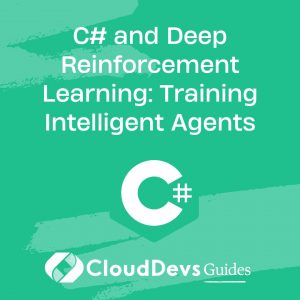C# and Deep Reinforcement Learning: Training Intelligent Agents
Table of Contents
Deep reinforcement learning (DRL) is a powerful technique in artificial intelligence that combines deep learning and reinforcement learning principles to train intelligent agents. With C#’s extensive libraries and robust framework, you can implement and experiment with DRL algorithms effectively. This article explores how C# can be leveraged for deep reinforcement learning and provides practical examples to get started.

Understanding Deep Reinforcement Learning
Deep reinforcement learning involves training an agent to make decisions by interacting with an environment. The agent learns to maximize cumulative rewards through trial and error, guided by a deep neural network that approximates the optimal action-value function.
Using C# for Deep Reinforcement Learning
C# offers a comprehensive set of tools and libraries that can be used to implement DRL algorithms. Below are key aspects and code examples demonstrating how C# can be employed for training intelligent agents.
1. Setting Up the Environment
The first step in DRL is to create an environment where the agent can interact and learn. C# allows you to design and simulate environments with ease.
Example: Creating a Simple Grid World Environment
This example illustrates how to set up a basic grid world where an agent moves to find a goal.
```csharp
using System;
class GridWorld
{
private int[,] grid;
private (int x, int y) agentPosition;
public GridWorld(int width, int height)
{
grid = new int[width, height];
agentPosition = (0, 0); // Start at the top-left corner
}
public void MoveAgent(string direction)
{
switch (direction)
{
case "up": agentPosition.y = Math.Max(0, agentPosition.y - 1); break;
case "down": agentPosition.y = Math.Min(grid.GetLength(1) - 1, agentPosition.y + 1); break;
case "left": agentPosition.x = Math.Max(0, agentPosition.x - 1); break;
case "right": agentPosition.x = Math.Min(grid.GetLength(0) - 1, agentPosition.x + 1); break;
}
Console.WriteLine($"Agent moved {direction}. New Position: ({agentPosition.x}, {agentPosition.y})");
}
}
```
2. Implementing the Q-Learning Algorithm
Q-learning is a foundational DRL algorithm that helps the agent learn the optimal policy by updating a Q-table based on rewards from the environment.
Example: Basic Q-Learning in C#
Here’s an implementation of the Q-learning algorithm in C#.
```csharp
using System;
using System.Collections.Generic;
class QLearning
{
private Dictionary<(int state, int action), double> qTable = new Dictionary<(int, int), double>();
private double learningRate = 0.1;
private double discountFactor = 0.9;
public void UpdateQValue(int state, int action, int reward, int nextState)
{
var maxQNext = GetMaxQValue(nextState);
var currentQ = GetQValue(state, action);
var newQ = currentQ + learningRate * (reward + discountFactor * maxQNext - currentQ);
qTable[(state, action)] = newQ;
}
private double GetQValue(int state, int action)
{
return qTable.TryGetValue((state, action), out var value) ? value : 0.0;
}
private double GetMaxQValue(int state)
{
double maxQ = 0.0;
for (int action = 0; action < 4; action++)
{
maxQ = Math.Max(maxQ, GetQValue(state, action));
}
return maxQ;
}
}
```
3. Training Deep Neural Networks with C#
To handle complex environments, deep neural networks can be integrated with reinforcement learning. C# supports various libraries for neural network implementation, such as `Accord.NET` or `TensorFlow.NET`.
Example: Setting Up a Neural Network with Accord.NET
Below is a simple example of how to create and train a neural network in C# using Accord.NET.
```csharp
using Accord.Neuro;
using Accord.Neuro.Learning;
using Accord.Neuro.Networks;
class DeepQNetwork
{
private DeepBeliefNetwork network;
public DeepQNetwork(int inputSize, int outputSize)
{
network = new DeepBeliefNetwork(inputSize, outputSize, 10);
new GaussianWeights(network).Randomize();
network.UpdateVisibleWeights();
}
public void Train(double[][] inputs, double[][] outputs)
{
var teacher = new BackPropagationLearning(network)
{
LearningRate = 0.1,
Momentum = 0.9
};
for (int epoch = 0; epoch < 1000; epoch++)
{
double error = teacher.RunEpoch(inputs, outputs);
Console.WriteLine($"Epoch {epoch}, Error: {error}");
}
}
}
```
4. Simulating and Evaluating the Agent’s Performance
After training the agent, it’s crucial to simulate and evaluate its performance in the environment. C# allows you to run simulations and track metrics like reward accumulation and decision accuracy.
Example: Simulating the Trained Agent
Here’s how you might simulate the agent’s actions in the environment and evaluate its performance.
```csharp
using System;
class Simulation
{
static void Main()
{
var environment = new GridWorld(5, 5);
var agent = new QLearning();
for (int episode = 0; episode < 100; episode++)
{
int state = 0; // Assuming some initial state
for (int step = 0; step < 50; step++)
{
int action = ChooseAction(state); // Implement an action selection policy
environment.MoveAgent("right"); // Example action
int reward = GetReward(state, action); // Implement reward calculation
int nextState = GetNextState(state, action); // Define state transition logic
agent.UpdateQValue(state, action, reward, nextState);
state = nextState;
}
}
}
}
```
Conclusion
C# provides an effective environment for implementing deep reinforcement learning algorithms. From creating environments to training deep neural networks and simulating agent performance, C# enables you to explore and apply DRL in various domains. By leveraging these capabilities, you can train intelligent agents to solve complex problems and make informed decisions.



